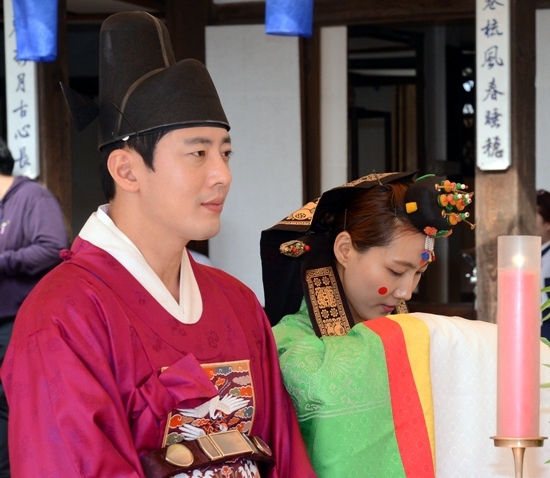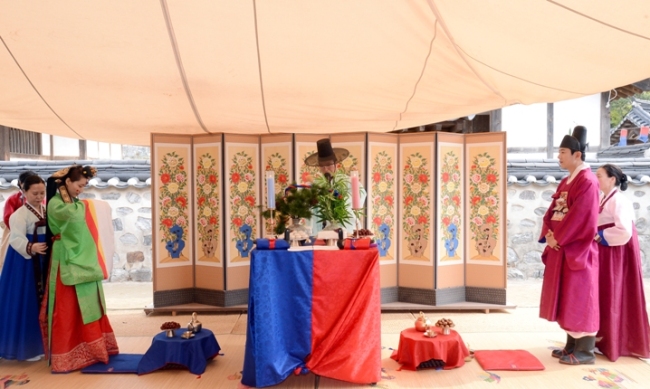하지만 혼례는 근엄한 행사였다. 혼례 여섯 단계 중 둘째인 관세위는 신랑신부가 준비된 물에 손을 씻는 예식인데, 이는 몸과 마음을 정결히 준비한다는 의미를 지니고 있다. 교배례는 신랑신부가 얼굴을 마주하고 서로에게 절하는 과정이고, 술로 혼인을 맹세하는 합근례가 이어졌다. 마지막 서배우례는 부부가 한평생 서로 공경하고 사랑하겠다는 맹세이다.
전통 혼례는 과정이 복잡하기 때문에 요즘 스마트 시대 젊은이들은 다소 답답하게 느낄 수 있다. 하지만 이런 과정 하나 하나를 통해 충실한 결혼 생활이 무엇인지 돌아보게 된다.
김소정 씨도 이에 동의했다. “서양식 결혼식과 달리 전통 혼례는 결혼 생활의 본질이 무엇인지 생각하게 합니다. 보여주기 위한 행사가 아니라, 서로에게 겸손하고 충실한 부부가 되라는 의미가 담긴 절차이죠.”
혼례 전통은 중국에서 유래해 유교와 함께 도입되었지만, 절차나 방식은 각 지역과 가문에 따라 독특한 양상을 띠었다. 국립 민속 박물관 최은수 학예연구관에 의하면 혼례 예식은 조선 시대 사회 정치 구조와 함께 여러 차례 탈바꿈했다.
“오늘날 우리가 흔히 말하는 전통 혼례는 조선 후기와 일제 시대 형식에 가깝습니다. 현대에 들어 일부 예식은 간소화 되었습니다.”
조선 시대에도 혼례에 적잖은 비용이 들었다. 최순근 학예 연구관은 “혼례는 신부 집에서 치뤘다”며 “하객 접대 음식과 신랑측에 예물에 보내는데 상당히 많은 돈을 썼다”고 말했다.
집안이 여의치 않아 혼례를 치루기 힘든 사람들은 돈을 모아 의복을 장만해서 돌려 입었다고 한다. 지인을 통해 혼례복을 입는 경우도 많았지만, 그것도 어려운 사람들을 위해 정부가 사모관대와 말을 빌려줬다고 한다. 조선 시대는 계급간 의복 규율이 엄격했으나, 혼례날만큼은 평민도 관복을 입고 신부는 공주가 입는 녹색 원삼이나 활옷을 입을 수 있었다.
전통 혼례는 많이 간소화되었지만 비용과 특수성으로 인해 젊은 커플들의 관심이 부쩍 늘었다.
서울의 한 결혼식장 직원은 “서양식 결혼식은 비용 부담이 상당히 크다”며 “이에 비해 전통 혼례는 경제적이고, 독특하기 때문에 전통 혼례를 많이 찾는다”고 설명했다.
실제로 하객 200~300명을 초청해 서양식 결혼식을 치르면 최소 천 만원은 예상해야 한다. 반면 김소정씨 부부는 100만원 내에서 식과 전통 공연단가지 해결했다고 한다. 전통 혼례식장을 이용하면 기본 요금은 최소 90만원 선, 여기에 가마, 공연, 폐백상을 선택하면 추가 비용이 든다. 일부 식장은 입장료를 받기도 한다.
수도권에서는 파티움성균관(구 유림웨딩홀)•한국의집•남산골한옥마을•운현궁•관악예절원에서 전통 혼례를 예약할 수 있다.. 경기도 과천 서울경마공원과 용인 한국민속촌 또한 대표적인 전통혼례식장이다. 각 지역의 향교나 문화원 중에도 전통혼례를 진행하는 곳이 있다.
<관련 영어 기사>
Searching for spiritual value of marriage
Interests in Korean traditional weddings growing as an alternative to extravagant modern versions
By Cho Chung-un
Like many other women, Kim So-jeong dreamed of walking down the aisle in a pearl-white silk dress with a sparkling tiara on her head.
But the 31-year-old office worker chose to do something different for her big day -- taking hanbok over wedding gown and jokduri, a traditional coronet, over tiara.
“I wanted to show my children, my grandchildren later in my life that I married their father not in a conventional wedding hall, but in a historic place where tradition is alive,” she said.
Kim married Daniel Kelley on April 21, in the courtyard of Unhyeong Palace in Jongno, central Seoul. The Joseon palace was the birthplace of King Gojong (1852-1919) and the royal residence where his wife Queen Myeongseong prepared her own wedding.
Incorporating aspects of wedding ceremonies held by noble families during the Joseon era (1392-1897), the bride tied the knot dressed in beautifully embroidered red hanbok. The groom also wore traditional attire -- a gwanbok, which represented the man’s high social standing in the Joseon era.
Their wedding followed six ceremonial procedures of a Joseon wedding.
From jeonanrye, meaning the groom’s arrival to the bride’s house and his offering of a set of wooden geese to her mother as an oath of lifelong love, to hapgeunrye, the last part of the ceremony when the bride and the groom drink from separate halves of a gourd and then reunite the two cups, symbolizing that two have become one, each stage was a nod to the meaning of a devout marriage.
“I think it was breathtaking. Each session was really poetic and has inspired us to rethink what a marriage life should be,” said the groom’s mother, who is from the United States.
The Korean traditional wedding, called honrye in Korean, was the biggest event for each man and woman.
“Honrye signified a starting point of adulthood. Those who didn’t get married through this important ceremony, they were regarded as the most undutiful ones and were not accepted as part of their communities,” Jung Jong-soo, a historian wrote in his book titled “The Life of a Man.”
Unlike today, the ceremony took about three days because it was an important event not only for newlyweds and their families but for the entire village.
“It was a big feast for the community where people enjoyed humor and wit,” said Lee Seong-ho, Confucian scholar at Sungkyunkwan University in a previous interview.
Villagers used to make jokes about the groom, a newcomer to the bride’s house where honrye usually took place, or play pranks such as tripping him from behind.
But keeping the ceremony as formal as possible was a must. As soon as the groom arrived for the wedding of the marriage mostly arranged between families, a series of ceremonial procedures were followed.
In gwansewee, second of the six procedures, the bride and the groom washed their hands to keep body and soul pure and clean.
The bride and groom faced each other and bowed as a promise of commitment during a session called gyoberye and then rose up and poured cups of rice wine to take an oath to the heavens and the earth that they would become a happy couple.
In seobaewurye, they vowed to love and honor each other all their lives.
The six-stage ceremony may look old-fashioned and perhaps boring for inhabitants of fast-paced modern Korea where spiritual values are often ignored. But all of these sessions seemed to revive the meaning of a faithful marriage, Kim said.
“Unlike western weddings, my Korean traditional wedding had rituals that made us think what marriage really is. It was not an event mainly for show but filled with meaningful procedures that made us humble and faithful,” Kim said.
The wedding traditions originated in China, as Joseon society was influenced by the neighboring country’s Confucian culture, but the content and style differed between regions and families. It underwent a series of changes due to social and political transformations, according to Choi Eun-soo, a curator at the National Folk Museum of Korea.
“The traditional Korean wedding we know today is perhaps close to ceremonies held in late Joseon and the Japanese colonial era. Some of the rituals were modified in the modern era under the simplified family rite standards enacted by past governments,” she said.
Honrye cost a lot of money even in Joseon times, particularly for the bride’s family.
“The ceremony took place in the bride’s house. They had to prepare the food and drinks for the guests and also had to buy expensive wedding gifts for the groom’s family,” said Choi Soon-guen, senior curator at the museum.
For those who find it difficult to get married because of financial issues, state offices borrowed robes and other materials needed for the ceremony, Choi explained.
But it was not that difficult to get wedding attire for the bride and groom because each village had its own costumes for community members, he added.
The traditional Korean wedding may be smaller in scale than ceremonies of the past, but more young couples in Korea are considering the traditional event as an alternative to lavish and expensive modern weddings.
“Couples face financial issues because western weddings often cost a lot. The number of young couples who consider having a traditional Korean wedding is steadily growing because it is much more economical and unique,” a wedding manager in Seoul said.
The idea of a small wedding also grabbed attention from the international couple, Kim and Kelley.
“I really didn’t want to have a wedding that is filled with guests who I don’t really know. I invited only my close friends and family members. And getting married with the blessing of people I really love was amazing,” Kim said.
The traditional wedding was much cheaper than western style ceremonies which cost at least 10 million won ($9,000) for about 2-300 guests.
The couple spent less than 1 million won for the entire ceremony which even featured artists performing Korean traditional music for the guests, they said.
(
christory@heraldcorp.com)







![[Herald Interview] 'Trump will use tariffs as first line of defense for American manufacturing'](http://res.heraldm.com/phpwas/restmb_idxmake.php?idx=644&simg=/content/image/2024/11/26/20241126050017_0.jpg)
![[Exclusive] Hyundai Mobis eyes closer ties with BYD](http://res.heraldm.com/phpwas/restmb_idxmake.php?idx=644&simg=/content/image/2024/11/25/20241125050044_0.jpg)
